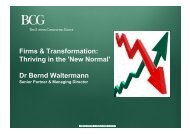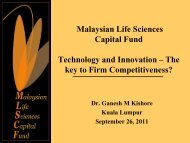SUMMARY
SUMMARY
SUMMARY
- No tags were found...
You also want an ePaper? Increase the reach of your titles
YUMPU automatically turns print PDFs into web optimized ePapers that Google loves.
<strong>SUMMARY</strong>
QuestionsWhat is the trajectory we are on, andwhere are we on that trajectory?If the world’s economy has undergone astructural change, what is the newequilibrium?What is the new global economic model?What are the imperatives of this newequilibrium? How do firms, societies andthe economy locate themselves in thisnew equilibrium?
Day 1 –Special Address: The Indian Economy:Some InsightsDr Yaga Venugopal ReddyMacroeconomicPolicyManagement• Stability: Reserve Bank of India (RBI) continued to place priorities on price stability,well-anchored inflation expectations, and orderly conditions in financial markets whilesustaining the growth momentum.• On interest rates: RBI monetray policy should be tighter. He said charges thatgrowth would be hurt because of RBI’s rate hikes have been belied.• On exchange rates: The rupee cannot be allowed to appreciate excessively in aneconomy, which runs a current account deficit, a wide trade deficit, and a wide fiscaldeficit.FinancialSectorsRegulation• On financial markets: Dr. Reddy said it is not possible to develop the financialmarkets without changes in policy and the real sector. It is not possible to have amarket for interest rate futures in an inadequate and imperfect spot market, withdifferent level of preparedness between foreign banks, public sector banks, andcorporates.• Prudential Guidelines: Given that the banking sector remain as the single mostimportant intermediary in the Indian economy, therfore pridential guidelines forspecific off-balance sheet exposures of banks is important. Regulations in respect tocapital adequacy, liquidity, and disclosure norms for non-bank financial companies(NBFCs) are equally important.Potential FDIsfor MalaysianCompanies• There are huge potential for foreign direct investment (FDI) between Malaysian andIndia, particularly in terms of economic infrastructure (i.e. water, power, etc.) andsocial infrastructure (i.e. education, health, etc.)
Day 1 ‐ Session 1: Macro and MarketsSimon Ogus, Dato’ Ooi Sang Kuang,Prem Manjooran, Stephen Taran, Iqbal KhanGlobalEconomyAsianEconomiesMalaysiaEconomy• Worst is over. Consensus view is that the worst of the crisis is over. Great Depression 2.0 hasbeen averted as the worst case scenario discussed last year did not materialised.• However, outlook still uncertain. The financial system has yet been fully recapitalised; andthe US consumer is still in a multi-year deleveraging process. Inventory re-stocking and fiscalstimulus have held up growth rates thus far, but private sector demand have not picked up in ameaningful way. Given this, the sustainability of growth moving forward remains questionable,and any potential growth rates are likely to be lower than pre-crisis levels.• Markets to remain volatile in the near term especially given the polarity of opinions. Thecurrent rally appears in line with a relief rally. Possible sign-posts for a sustained bull-marketmay include meaningful reduction in US unemployment, sustainable growth in China as well asthe emergence of revenue growth as an earnings driver.• Rebound stronger than expected. However, Asia needs to deliver on domestic demand reorientationas it is still too trade-dependent. A meaningful rebalancing will take time given thestructural issues (E.g. building social safety nets) involved.• Execution key for any future stimulus even though many Asian economies are still in theposition to do so. With the exception of China, the ability of the rest of Asia to deliver oninfrastructure stimulus is debatable.• No decoupling for Asian asset markets given significant presence of global cyclical playersamong listed companies.• Malaysia on recovery path, supported by fiscal stimulus plan and improving private sectordemand. Wages in the manufacturing sector have grown and the pace of retrenchment haveslowed.• Malaysia may also derive less marginal benefit from further infra-based stimulus givenits relatively well-developed infrastructure.
Day 1 –Session 2: Firms and TransformationIdris Jala, Jamaludin Ibrahim,Daniel R Fung, Yvonne Chia, Bernd WaltermannTransformation• Transformation: entails fundamental change in the way organisation does business andthe character of the organisation. Drastic changes favoured instead of incremental changes• Key Areas: 8 laboratories set up under the Government Transformation Programme toaddress crime, corruption, education, low income household, rural basic infrastructure, andurban public transport. Report targeted for January 2010.Crime &Corruption• Anti-corruption campaign / policy dependent on the state of economy• 3-prong approach: enforcement, capacity building and education• Public sector vs Private sector: linked symbiotically; public sector is comparatively easierto reform (top down approach)HumanCapital &ProductivityGlobal &RegionalChampions• Social contract: crisis environment puts strain on employee relations e.g. pay cuts, trainingbudget, entertainment etc.• Quantity vs Quality: to eliminate non-performers and incentivize top performers toincrease total productivity• Increased productivity: employees can perform better with incentive and performancemeasures• Need for differentiation: to identify and excel in niche markets• Chosen ones: to identify companies (top 10) and allocate all resources to create regional /global champions; organic growth will not work• Entrepreneurship: balance between encouraging risk-taking and government intervention
Day 2– Session 3: Competitiveness and DevelopmentAndrew Sheng, Dr. Danny QuahMartin Jacques, Atul Bhargava, Karim RaslanNetworkcrisis• Criterias to locate in the new normal (the 7 Cs – competition, core competence, clustering,coherent, choice, capacity and culture)• Geographic space to be taken advantage of via social and economic network connection• Peoples vs Systems and Individuals vs InstitutionsGlobalPerspectiveLessons forMalaysia• Post-crisis perspective: to be based on historical evidence or facts but not dogma / ideology,to aim for poverty reduction, to develop partnership within commonality of interest as well as toimprove governance• Over the next decade the world is predicted to shift into a completely different paradigm inwhich China’s GDP will double that of U.S. in the year 2050. BRIICs will have higher income.With economic power, China and other large developing countries will exert power on otherstrategic interest• Advantages: Malaysia needs to focus on its comparative advantages and to understandand deal with it’s weaknesses to avoid from being handicap. Malaysia should capitalize onthe small size, human capital, skills and resources capability and availability• Country model such as Netherlands – a low profile country yet has a high standard ofliving should be a role example for Malaysia to benefit from the rise of China, India andIndonesia with technology and investment as leverage.• Integration of technology into education would facilitate the country towards aknowledge and innovative-led economy. In the absence of human capital, technology andinnovation does not exist. Malaysia has to be bold and creative to attract and retainexisting and potential investors• Execution is crucial. Actions need to be taken now otherwise we will be in the middleincome trap forever
Day 1 –Special Address: Islamic FinanceDr. Abbas MirakhorFinancialGlobalization• Irreversible: Globalization is irreversible. Countries have no choice but to join. Laterjoiners have difficult time catching up.• Benefit: Financial globalization will reduce cost of capital globally, provide opportunityfor diversification, reduce volatility and increase stability, higher income & growth andreduce poverty and inequality• Prerequisite: Capital flows to high return/risk market. However to benefit, countrymust reform to good governance, reform in financial sector, legal reforms to benefit.Countries with high corruption level may not benefit from financial globalization.• Lucas paradox: higher equity flow among developed countries and home biasedbehavior even though risk-adjusted is higher overseas. Large premium, largerdifferential between equity and risk free assets. (equity premium puzzle)IslamicFinance• Development: Islamic finance on its path in its development. The path will convergewith the traditional finance as it need the same prerequisites – institutional reforms,property rights, transparency• Risk sharing: Islamic Finance puts more emphasis on property rights, contracts, trustand cooperation to ensure maximum risk sharing. It will result in higher growth andreduce inequality and poverty• Link to real sector: Reduces the risk of financial crisis. Reduces high leverage.• Rules of behavior: Islam ordains moderate consumption, production – rules outwaste, good governance, resources are created for all humanity (against monopoly)
Day 2 –Luncheon Address: Underlying trendsand Imperatives in BusinessDominic BartonTrends• Urbanization – rising middle class of consumers especially from India and China• Infrastructure spending and the size of projects steadily increasing• Asia’s share of the top companies is increasing• Water is scarce especially where water is needed the most• Rising inequalityThe NewNormal?Imperatives• The core assumptions of finance are being questioned; country level measures,neoclassical economics and the efficient market hypothesis• Public sector performance and corporate performance – different metrics tomeasure strength of companies• Capture the massive new middle-class consumer group• Fire up the innovation engine• Build risk capacities for the new normal• Upshift talent management capabilities• Help build the soft infrastructureMalaysia is well positioned to win in the “new normal”
Day 2 –Session 4: Leadership & SocietyNazir Razak, Juan Villalonga Navarro,Dr Martin Gargiulo, Ravin Jesthasan, Awadh Al KetbiLeadershipMatters• In an increasingly volatile world, risk mitigation and flexibility will be a premium.• Leaders who can deliver results, risk taking behavior, responsible & accountable forfailures.• Create values for family, company and society.• Importance of the ambidextrous leader.Talents andLeadershipParadigm/RolesNew SocialNetworks• 3 ways to create values: develop character through integrity, effective communicationwith humility and leadership through service.• Leadership through different levels: fresh graduate, middle management, highermanagement, professionals and CEO.• 4 stages of leadership developments: Identifying high flyers, training & development,enabling changes and strategic position.• Education for future leaders.• Focus on a limited number of functions and pursue alternative staff strategies – truly“networked” organizations.• Partnering with other organizations.• Network with big cities.• Network needs clusters of tightly connected group “Islands” & “Bridges” betweenclusters to contrast ideas.• Network with integrity, creativity, successful & self sustained




